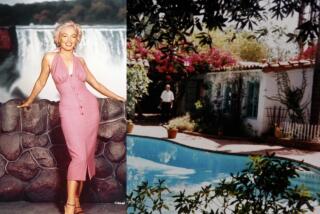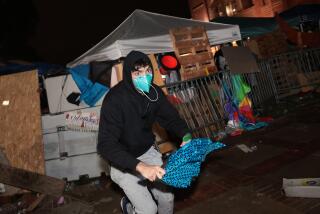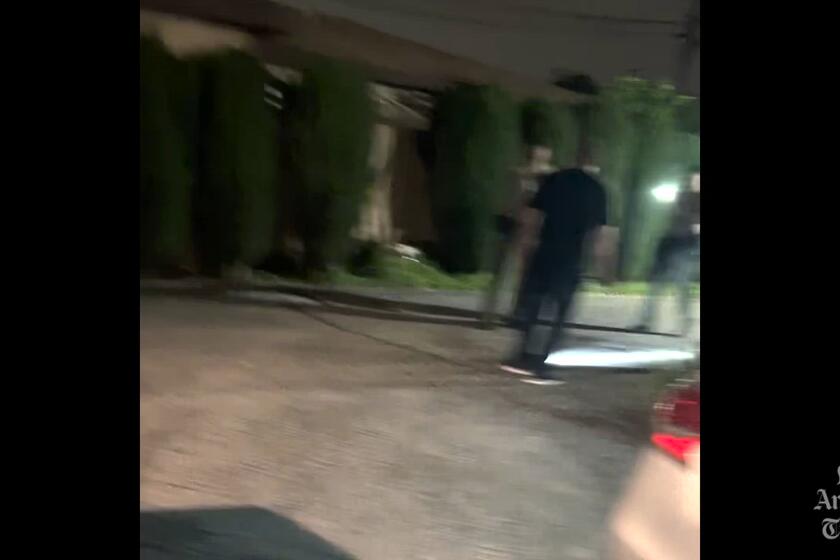Error Leads to Era Before the Chumash--an Ojai Dig
An improperly placed guest cottage in an exclusive Ojai subdivision has led archeologists to what may be the remains of a 2,000-year-old Indian village.
Such finds are rare and can help yield valuable information about the people who predated the Chumash, according to archeologists studying a wealth of artifacts they have uncovered in a dig at the Rancho Matilija subdivision.
Indian sites more than a few hundred years old are “very difficult to find . . . and very difficult to date,” said archeologist John Foster. “That’s why this site is so important.”
Roberta Greenwood, the Pacific Palisades archeologist who oversees the excavation, said in a preliminary report that some of the Rancho Matilija property is so promising that it may “meet the criteria for nomination to the National Register of Historic Places as an archeological district.”
The designation would not limit the property owners’ right to use their land, but would “underscore the importance of the sites to regional research and the responsibility of the county in taking all possible steps to protect and conserve the scientific and Native American values represented.”
Before the subdivision was approved in 1980, consultants studying the Rancho Matilija oak groves, which lie about 5 miles from the center of Ojai, discovered “a significant site with potential for contributing to research concerned with the inland Chumash.”
The county declared parts of five lots an archeological preserve and barred development there. However, Jim Miller, a Santa Barbara-based contractor who bought one of the lots in 1986, last year built his guest house 5 feet into the forbidden territory.
“With what I know now, maybe there shouldn’t be anything built near that place,” Miller said. “Unfortunately, I bought the property and was told I could build on it.”
When he realized the error, Miller informed county officials. Rather than risk more damage to the site through demolition of the bungalow, they ordered Miller to hire an archeologist to evaluate the area.
The study will cost Miller an estimated $10,000. Earlier this month, an archeological team site sifted through trays of gravel and rocks, seeking clues to the identity of the earlier residents of the oak groves.
A gray fleck of volcanic glass spoke volumes to Foster, an archeologist for 18 years.
He surmised that the obsidian chip hit the ground under the oaks of Rancho Matilija as someone was fashioning an arrowhead. It told him that at least a few prehistoric residents were hunters, and that they traded with other Native Americans from California’s Central Valley, since obsidian is found there, but not anywhere near what is now Ventura County.
The significance of the Rancho Matilija site, Foster said, could lie not merely in the information it will yield about the Indians who lived there, but in its potential to fill in the gaps of information about other sites.
Bones Can Be Dated
Among the artifacts were bits of burned animal bones. These can be radiocarbon-dated to find out when the band of Indians lived on the Rancho Matilija land. In turn, researchers may pin that date on other sites that have yielded obsidian chips, for example, but no bones or other organic material that can be dated.
The radiocarbon-dating will take a month or more, Foster said. And, he acknowledged, until that test is done, nothing is certain.
The earliest known Southern Californians, called the Milling-Stone Horizon people, inhabited the region about 7,000 years ago, and made extensive use of milling stones for grinding seeds. Hunters started to roam on the area about 3,000 years ago, and the Chumash, highly organized and expert in the use of bone, shell and stone, are thought to have reached their cultural zenith about 1,000 years ago.
But considering what has been found and what has not been found there, archeologists are betting that Rancho Matilija is a middle-period Indian site about 2,000 years old.
There are, for instance, the manos --20 or so taken from one of the five precisely measured holes that the team excavated. Looking like little more than weather-rounded stones, they have been shaped by human hands, Foster said, rounded to fit against the flat or slightly concave surface of a milling-stone and used to grind seeds.
Foster asked excavator George Toren to move aside in the hole he was painstakingly finishing, using a hand trowel and paint brush to carefully carve the earth from the artifacts. Near the bottom of the hole was a flat stone with a concave surface: a milling stone.
“The tool kits changed through time,” Foster said. “You never saw mortars and pestles in the earlier periods; the people used manos and milling stones to grind seeds. They weren’t processing acorns.” Acorns contain a bitter substance that must be processed out.
“The middle-period people didn’t know that, or thought it was too much work. When they finally learned how to process acorns, we saw an incredible rise of mortars and pestles,” Foster said.
The Rancho Matilija excavation has turned up no mortars, no pestles. It’s a clue, said Foster, that the site predates the Chumash.
Important Clues
The obsidian fleck, one of scores found at the site, and a lone obsidian arrowhead also are clues.
“In the middle-period sites, there was a brisk trade in obsidian,” Foster said. Sometime between the middle and late periods, the Indians switched to fused shale, which is found locally. “This site has a lot of obsidian in it, and very little fused shale,” Foster noted.
A third clue that the village’s inhabitants weren’t Chumash comes from something that’s missing: seafood remains.
“This site doesn’t have any shellfish in it at all,” Foster said. The Chumash ate a lot of shellfish, and archeologists usually unearth piles of shells in their villages. Foster’s team found only a few fish vertebrae at the Rancho Matilija site. “The amount of fish present here, relative to late Chumash, is nothing,” he said. “We feel on that basis alone that the site is earlier.”
Foster drew a sketchy picture of the lives of the site’s inhabitants.
In one excavation hole, a layer of charred rock was uncovered. “It could be an earth oven, or it could be a fire hearth,” Foster said. But it wasn’t the floor of a home. “They were living in small huts, or perhaps large huts, we don’t know which,” he said. “They might dig a slight concavity, then build a hut over it, of wood.”
Assuming that the site was a village, Foster said, the people living there “would probably get into groups and some would go off into the canyons and gather seeds while others hunted.” The band probably brought water from a nearby creek or from the Ventura River and stored it in baskets.
“We found some tarring pebbles,” Foster said. “The small stones were dipped into melted asphaltum, a tar-like substance that seeps naturally from the ground, then thrown into baskets and shaken around to give the baskets a waterproof coating.
Descendants of the prehistoric Indians are loath to have the remains of their ancestors’ civilizations disturbed. Archeologists agree.
“We don’t want to excavate these sites unless we absolutely have to,” Foster said. Although each site adds to the scant information on prehistoric cultures, “I’m destroying this site by excavating it. Once you dig it up, you can never replace it. You are destroying a page of a book, and how can you read a book without all the pages?”
More to Read
Start your day right
Sign up for Essential California for news, features and recommendations from the L.A. Times and beyond in your inbox six days a week.
You may occasionally receive promotional content from the Los Angeles Times.






